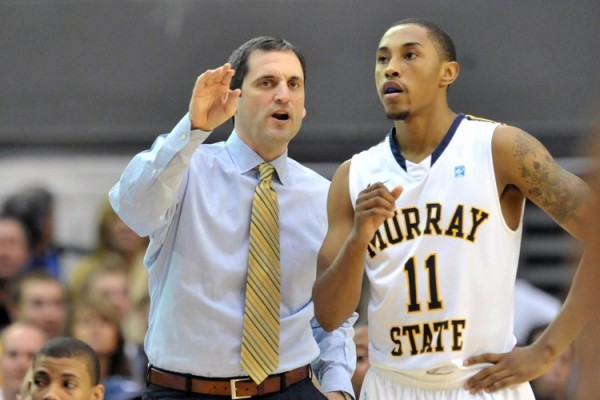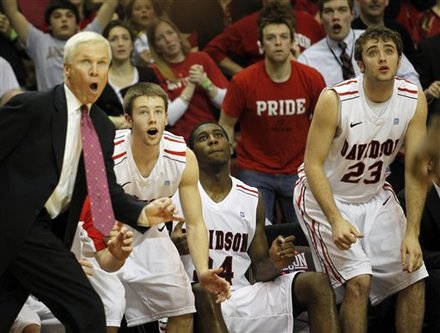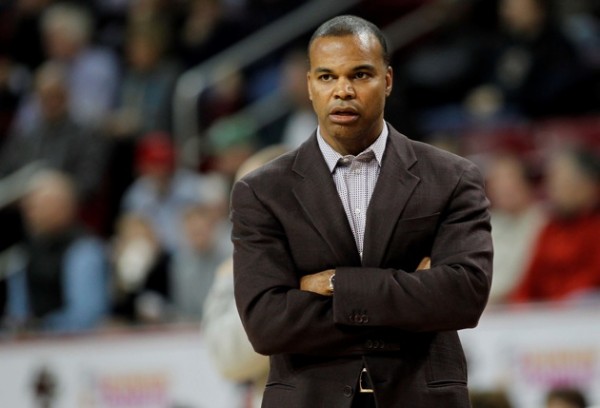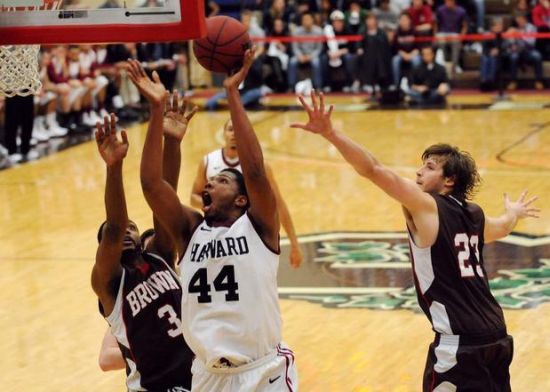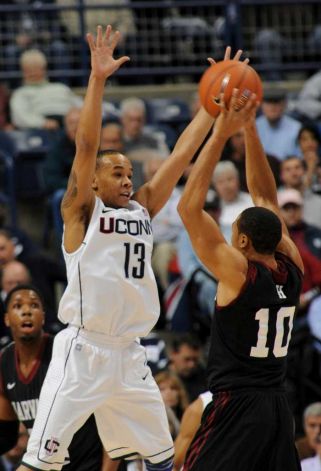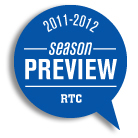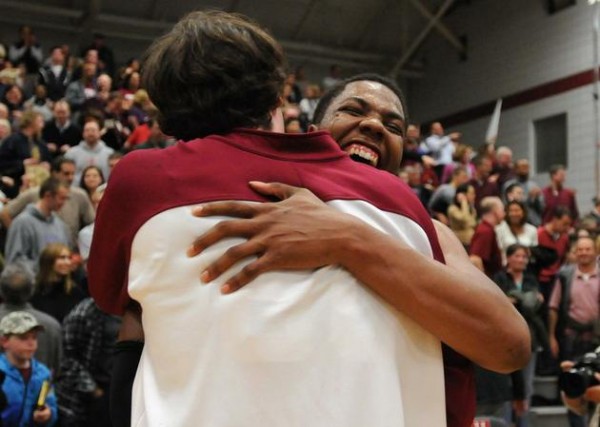
Howard Hochman is the RTC correspondent for the Ivy League.
The Aftermath – Princeton 63, Harvard 62
On a day of hoops hysteria and afternoon delights dominated by buzzer-beaters, ESPN live-look ins, and replayed highlights, none were as hysterical or as replayed as Harvard/Princeton. By now, you know the result, have read the front page of your local sports section, and have seen the dagger Doug Davis shot through every Crimson heart. The agate will simply read Princeton 63, Harvard 62. But this game was so much more than that. It was about players on both sides performing brilliantly under pressure, with the stars on both teams shining brightly in a packed and raucous Lee Amphitheater; matching basket for basket down the stretch. Ian Hummer to the hoop for a Princeton one point lead with 37 seconds left matched by a driving lay-up 26 seconds later by Brandyn Curry– who was magnificent- to keep the see-saw moving, setting the stage for Davis. The game will not soon be forgotten. Princeton moves on and is one of those clichéd opponents that “nobody wants to see in the first round” but John Calipari and Kentucky will. The only thing that could have removed the sting for Harvard is an at-large berth that they truly deserved. Instead, the committee rewarded a lot of also-rans from power conferences that inflated their record by playing all the schools with directional names in their home state and on their home court. Tommy Amaker went out and did what the NCAA asks — play a representative pre-conference schedule on the road –George Mason, UConn, Michigan, dancers all. And in fact, Harvard had a better RPI than 14 of the at-large teams selected. A travesty, but then again those other teams have fans who travel and contribute and we all know money talks. So they will play in the NIT and unlike some of the other teams who get the same “honor,” Harvard will show up and play their hearts out. Like Saturday.
NCAA Tournament Preview
Last year, Cornell won its first two tournament games and had become the darling of the country. They were a senior-laden team, dependent on scoring from beyond the arc. Next on tap were the Kentucky Wildcats and their team of NBA first rounders. But they were young. John Calipari had a week to prepare and allowed his team to hear the hype of the Brains vs. Brawn match up. And he convinced his team to play some aggressive D on the perimeter resulting in a Kentucky rout. The committee must have enjoyed last year, as Princeton draws Kentucky in the first round. Feline groovy.
The two teams had one common opponent, Penn, and neither lost. But in a game that kicked off the new year, Penn had the Wildcats on the ropes at Rupp for most of the first half before falling victim by 24. The difference was on the boards. Princeton will not be that overmatched inside thanks to Kareem Maddox and Ian Hummer who can definitely rebound with Josh Harrelson and Terrence Jones. The game may come down to how well the Tigers defend the three-point shooting trio of Brandon Knight, Doron Lamb and Darius Miller. Furthermore, the Wildcats are not deep. Only six play double figure minutes. They are in trouble if either Jones or Knight gets into foul trouble. So here is the recipe: stay close early, play even off the boards, draw some fouls and stop transition. Can be done but a tall order. Let’s go out on a limb here. The Tigers do what Cornell couldn’t, ride the wave of Doug Davis’s heroics, win one for the Ancient Eight and come away with a 68-66 victory.
Final Power Rankings
1. Princeton (12-2, 25-6)–won the title in a playoff game for the ages as chronicled above-and deservingly so; had a spectacular season; a nice core returns, even though Maddox and Dan Mavraides’ graduation will be big shoes to fill. Look for the Tigers to give the Kentucky freshmen all they can handle.
2. Harvard (12-2, 23-6)–as Bob Ryan of the Boston Globe so eloquently put it, “Princeton won, but nobody lost”; heads held high in defeat and truly deserved a spot in the field of 68; will be unanimous pre-season choice for 2011-2012 title with everyone coming back and a top recruiting class. A pre-season top 25?
3. Yale (8-6, 15-13)–Coach Jones thinks they should be one of the favorites next season and he may be right. Mr. Inside/ Mr. Outside, Greg Mangano (see below) and Morgan a formidable duo.” The Game” next year may be on the court instead of the field.
4. Penn (7-7, 13-15)–Underachievers? Perhaps, but they are a fun team to watch and have found a gem in Cartwirght; need to develop an inside presence to compete with the Hummers, Manganos, and Wrights of the world.
5. Columbia (6-8, 15-13)–will return leading scorer Agho and running mate Barbour so immediate respectability; nice first year for Coach Smith, who will look to recapture some of his St.Marys recruiting magic
6. Cornell (6-8, 10-18)–ended the season on an uptick, winning their last three; Coach Bill Courtney developed a system of playing everybody; Chris Wroblewski will be last trace of Big Red dynasty; keep an eye on recruiting class.
7. Brown (4-10, 11-17)–bright spot is their youth, particularly do-it-all guard Sean McGonagill; I like Coach Agel a lot, but with so much of Ivy nucleus returning will be tough to see any noticeable improvement in standings though.
8. Dartmouth (1-13, 5-23)—I wonder how Coach Cormier can keep his kids motivated; no immediate escape from the cellar is imminent; freshman guard Melville looks like a keeper; attracting more fans to the games may be a realistic goal.
The Second Annual Bradley Awards
It is time to honor the best of the brightest…those players, and coach, from the Ivy League who have distinguished themselves during this 2010-2011 basketball season. And the good news is, just about every one of this year’s recipients will be returning next year.
Coach of the Year: Certainly newcomers Kyle Smith at Columbia and Bill Courtney at Cornell appear to be on the right track. And Brown looks they could contend in the near future under Jesse Agel. But this year’s choice came down to the men who lead the two pre-eminent programs–Sydney Johnson of Princeton and Tommy Amaker of Harvard. Both did outstanding jobs and indeed had their teams prepared for the game of the year. However 90% of the country chose Princeton as their preseason choice with their starting team returning intact and two seniors. Harvard, on the other hand, lost POY Jeremy Lin, had a much more inexperienced nucleus, yet ended up with the better record and better RPI. So the Bradley goes to..Tommy Amaker.
Freshman of the Year: As alluded to in our previous column this was perhaps the toughest choice. Miles Cartwright of Penn came out of the gate on fire and perhaps is a future star. Laurent Rivard of Harvard proved invaluable as a sixth man helping the Crimson to a share of the title. But the Bradley goes to Sean McGonagill of Brown. The 6’1 guard from Illinois started every game since his arrival on campus. And he earned the coveted trophy with his versatility. He led the team in minutes played (33.3 per game), assists (5.2 pg), and free throw shooting (82%). He was third on the team in scoring (11.8) and rebounding (4.4). I have a feeling this will not be the last of his Bradleys.
Sixth Man of the Year: This one is almost unfair. Princeton is so well-balanced that they can afford to bring a Player of the Year candidate and one their two most important seniors off the bench. None other than Kareem Maddox. The 6’8 Californian was perhaps their most valuable player but started only four games. Yet he averaged over 30 minutes. The rest of his stats were equally impressive; 13.7 ppg (second on the team and 8th in the league) on 57% shooting from the field; and 7.0 rebounds per game (4th in the league). What would the Bradleys be without a Princeton representative?
All-Ivy Team:
-
G Noruwa Agho Columbia – 6’3 Jr. New City, NY–led the league in scoring at 16.8; fifth in assists at 4.3; contributed over four rebounds per game; started every game and played nearly 35 minutes per game
-
G Zack Rosen Penn – 6’1 Jr. Colonia, NJ–led team in scoring (14.6, 4th in league), minutes played (36. 7, 1st in league), assists ( 5.5, 2nd in league) and steals (1.3, 6th in league); defending RTC Ivy Player of the Year as a sophomore hit numerous clutch game winning or tying shots.
-
F Keith Wright Harvard – 6’8 Jr. Suffolk, Va–led team in scoring (14.9, 3rd in league), rebounding (8.5, 2nd in league) and in field goal percentage (58.8, 1st in league); started every game and combined with Kyle Casey to give Crimson tough inside duo.
-
F Ian Hummer Princeton – 6’7 So. Vienna, Va–tough choice over Jack Eggleston; yet it was Hummer’s all-around play and team success which ultimately gave him the nod ; 7th in league in scoring (13.9 led team), 6th in rebounding (6.7), 2nd in Fg % (55.7%) 4th in blocks (1.1); the Tigers’ go to guy
-
F Greg Mangano Yale – 6’10 Jr. Orange, Ct.–only Ivy player to average a double/double (16.3 ppg, 10.0 rebounds per game); was within .5 of a point from leading the league in both scoring and rebounding; led league in blocks with three per game; second in the league in shots taken but still shot over 48%; with running mate Austin Morgan, forms perhaps best returning inside/outside threat. And thus…
Greg Mangano is recognized as the 2010-2011 Bradley Award winner as Ivy League Player of the Year.
Defending the Jacket
Last year, we scored a coup, not only winning the RTC Bracket Pool (and the Hickory High letter jacket), but dominating the other two in which we participated. This gives me the right and responsibility to offer my thoughts on this year’s tournament — offered with a caveat; winning is tough, repeating near impossible. I have identified four factors which lead to NCAA success — free throw shooting, rebounding margin, shooting the three and defending it. Last season, Duke was the only team to appear in the top 40 nationally in the four categories. Xavier and St. Mary’s were the only others to appear in three and thus were recommended as likely to outlive their seed. This year, the same analysis provided some eye-opening information.
The eye test, based on watching all season long, has left me with the conclusion that Ohio State is the best team. But OSU appears in only one of the categories- so bye bye Buckeyes. And in fact, this season, NO team ranks in the top 40 in all four categories. But there are three teams in three. Those are Kansas, Arizona, and Texas. And the latter two, unfortunately, are on a collision course for a second round matchup in the West bracket. Arizona has the better numbers. So the Cats advance, knock off Duke in the regional final and advance to play Kansas in the championship game. We will let you take it from there. Let the Madness begin.






























